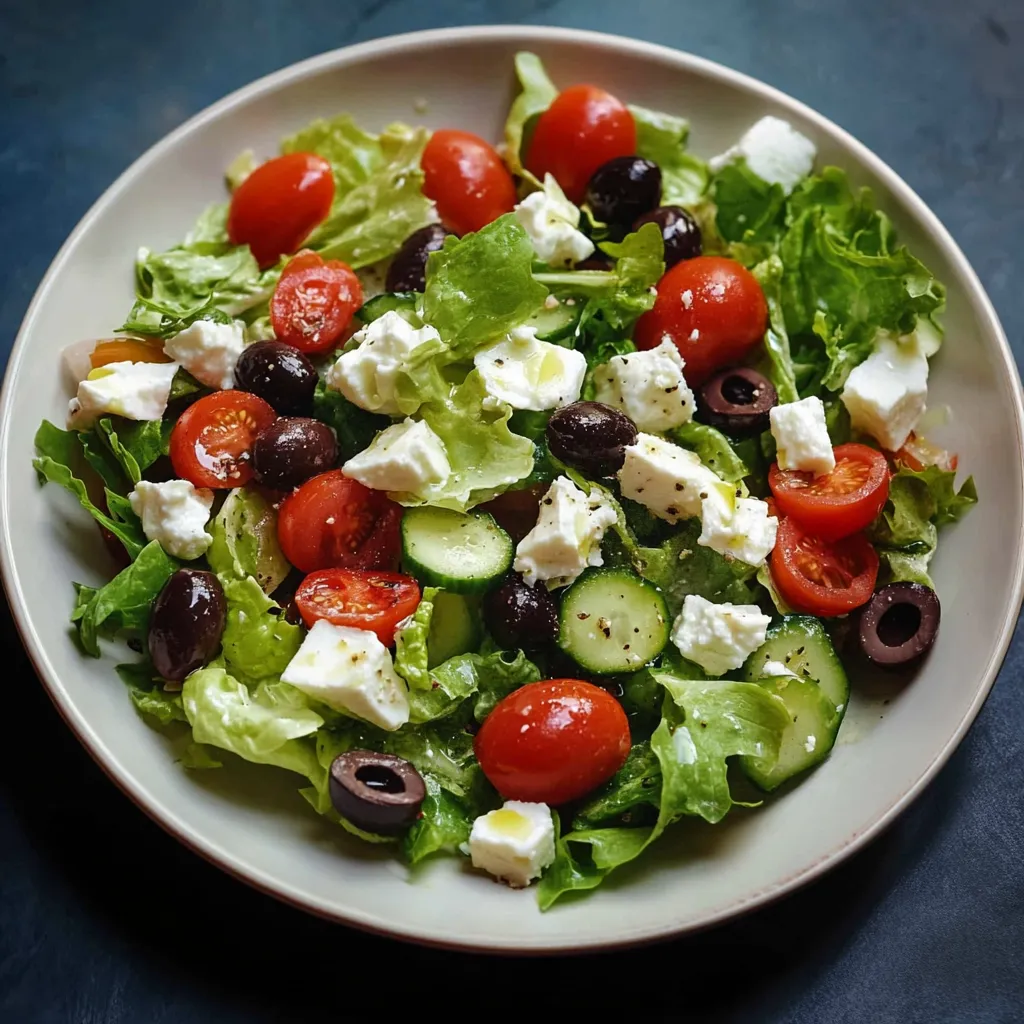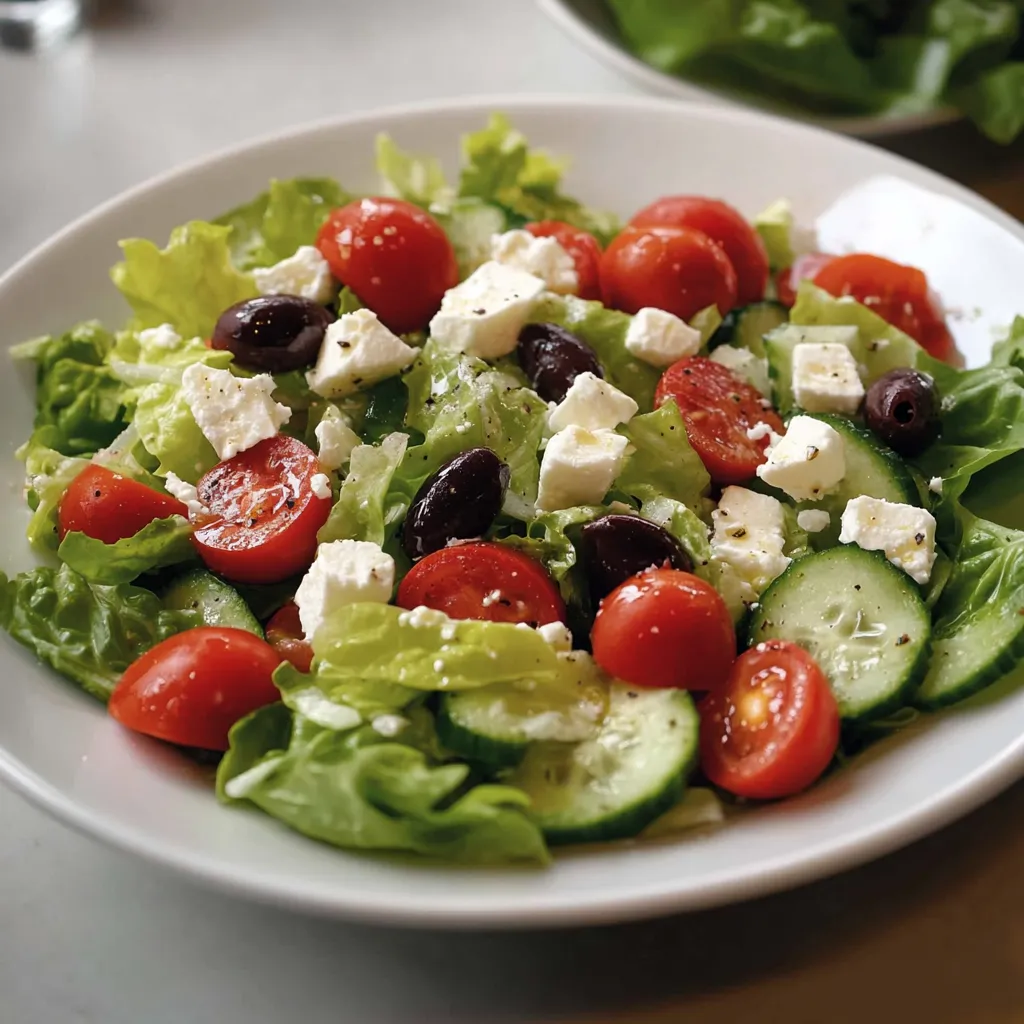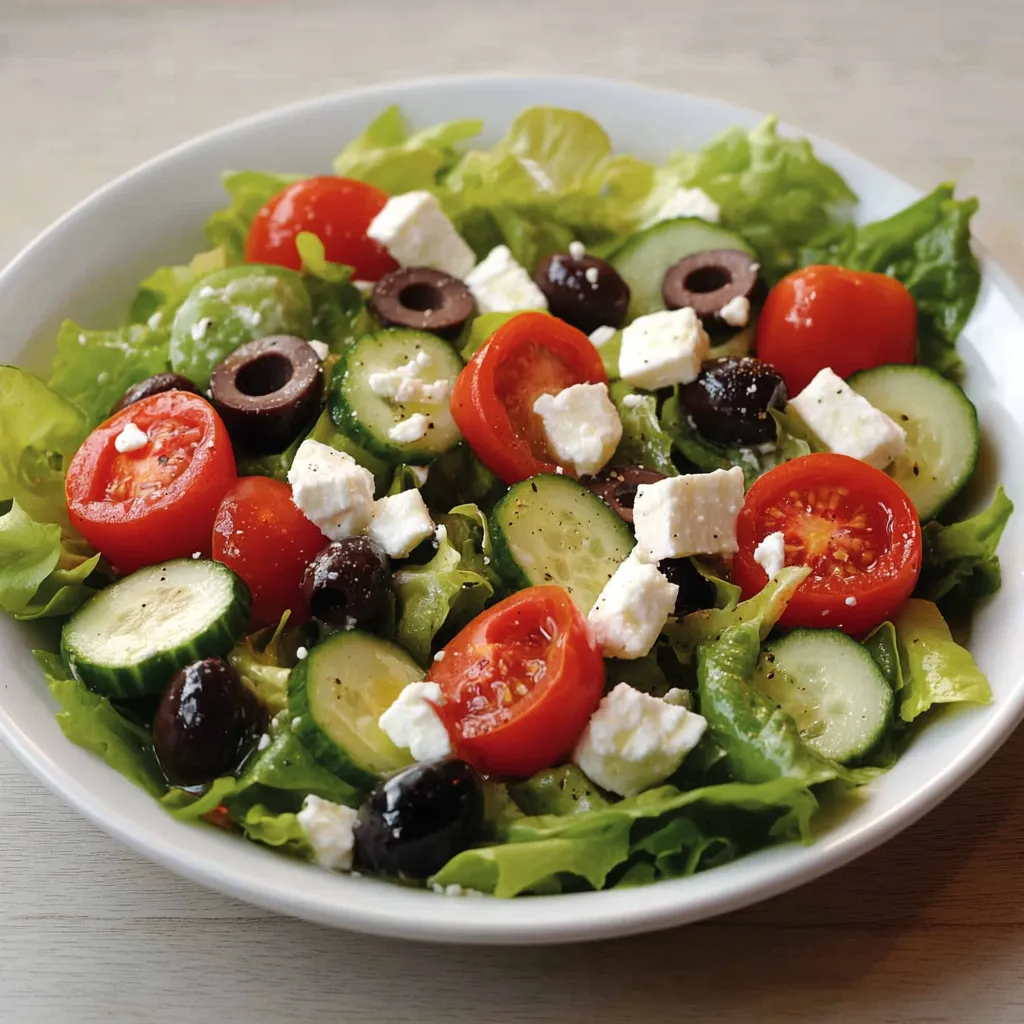 Pin it
Pin it
Greek Salad captures the essence of Mediterranean cuisine with its vibrant colors and refreshing combination of crisp vegetables and tangy cheese that transport your taste buds directly to a seaside taverna in Greece. This classic dish celebrates simple ingredients at their peak freshness, allowing each component to shine while creating a harmonious blend of flavors and textures in every forkful. The crunchy cucumber provides cooling hydration alongside sweet tomatoes bursting with juice, while purple onions add gentle sharpness that balances perfectly with briny olives scattered throughout. Crowning this colorful creation is creamy feta cheese that adds richness and distinctive saltiness, all brought together by an herbaceous dressing featuring Greece's liquid gold—extra virgin olive oil infused with aromatic oregano and brightened with fresh lemon juice that enhances each ingredient it touches.
I first experienced authentic Greek salad during a summer vacation to Santorini where local taverna owners served their version without lettuce, explaining that traditional horiatiki salad lets the vegetables speak for themselves. Upon returning home, I adapted their approach while incorporating romaine for additional substance, creating this version that bridges authentic Greek technique with American preferences. My family now requests this salad weekly during summer months when garden tomatoes reach their peak sweetness, making it our go-to accompaniment for grilled meats and seafood.
Prime Ingredients
- Romaine Lettuce: Creates the fresh, crisp foundation that holds other ingredients. Select heads with rigid, dark green outer leaves and pale yellow hearts for optimal flavor contrast and texture.
- English Cucumber: Provides refreshing crunch and subtle sweetness. Choose firm specimens with bright green skin and minimal seeds for the best texture and flavor.
- Vine Ripened Tomatoes: Contribute juicy sweetness and vibrant color. Look for tomatoes that feel heavy for their size with tight, glossy skin indicating peak ripeness.
- Kalamata Olives: Add distinctive briny depth and meaty texture. Authentic Greek varieties packed in olive oil rather than vinegar solution offer superior flavor complexity.
- Bell Peppers: Introduce sweet crispness and beautiful color contrast. Select peppers with firm, glossy skin and significant weight indicating thick, juicy walls.
- Red Onion: Provides gentle sharpness that balances the other ingredients. Choose medium-sized bulbs with tight, dry outer skins and firm texture throughout.
- Feta Cheese: Creates creamy richness and signature salty tang. Traditional Greek feta made from sheep's milk offers more complex flavor than cow's milk versions.
- Extra Virgin Olive Oil: Forms the luxurious base of the dressing that coats every ingredient. High-quality Greek olive oil with its distinctive peppery finish transforms the simple dressing into something extraordinary.
Preparation Method
- Prepare The Base
- Begin with one large head of fresh romaine lettuce, removing any wilted outer leaves before thoroughly washing each leaf under cold running water to remove any hidden dirt or debris. Shake excess water from each leaf and pat dry. Using a sharp knife, cut the romaine into bite-sized pieces.
- Slice The Cucumber
- Wash the cucumber and slice it into quarter-inch thick half-moons. If using regular cucumbers, peel alternating strips for a decorative effect while reducing bitterness.
- Prepare The Tomatoes
- Wash and cut vine-ripened tomatoes into bite-sized wedges or chunks. If using cherry tomatoes, halve them for a more consistent texture.
- Add Colorful Peppers
- Slice bell peppers into thin strips and then cut them into squares that match the size of the other salad components.
- Slice The Onion
- Slice a red onion into thin half-moons. To reduce sharpness, soak the slices in ice water for 15 minutes before draining and adding them to the salad.
- Prepare The Olives
- Pit the Kalamata olives and slice them in half, or leave them whole for a more authentic presentation.
- Crumble The Feta
- Use six ounces of high-quality feta cheese, crumbling it into irregular pieces to create interesting textural contrast.
- Mix The Dressing
- Whisk together extra virgin olive oil, fresh lemon juice, dried oregano, sea salt, and black pepper until emulsified.
- Assemble The Salad
- Layer the ingredients in a large serving bowl, finishing with crumbled feta cheese on top.
- Apply The Dressing
- Drizzle the dressing over the salad and toss gently to coat evenly.
 Pin it
Pin it
My grandmother always emphasized that quality feta should never be refrigerated directly before serving. Allowing it to sit at room temperature for 30 minutes enhances its flavor and texture.
Complementary Pairings
Serve alongside grilled lamb chops, warm pita bread, or mezze dishes like stuffed grape leaves and hummus.
Flavor Variations
Add thinly sliced fennel, chickpeas, or watermelon to experiment with different flavors while maintaining the salad’s core Mediterranean essence.
Optimal Storage
Store undressed salad in an airtight container for up to 24 hours. If meal-prepping, keep components separate and mix just before serving.
 Pin it
Pin it
Greek salad exemplifies Mediterranean diet principles, proving that simple combinations of quality ingredients create the most memorable culinary experiences.
Frequently Asked Questions
- → Can I make Greek Salad ahead of time?
- You can prep the ingredients up to a day ahead and store them separately in the refrigerator. Combine everything and add the dressing just before serving to maintain the crispness of the vegetables and prevent the lettuce from wilting. If you must assemble in advance, leave the dressing off until serving time.
- → What type of olives are best for Greek Salad?
- Traditional Greek Salads use Kalamata olives, which have a rich, fruity flavor. While this recipe calls for black olives, feel free to substitute with Kalamata for a more authentic taste. Just remember to pit them if they come with pits, or purchase already pitted ones for convenience.
- → Is there a dairy-free option for the feta cheese?
- There are several plant-based feta alternatives available in many grocery stores made from tofu or nuts. Alternatively, you can simply omit the cheese and add extra olives or a sprinkle of nutritional yeast for a savory element. The salad will still be delicious with just the vegetables and dressing.
- → What can I serve with Greek Salad?
- Greek Salad pairs wonderfully with grilled chicken, lamb, or fish for a complete meal. It's also delicious alongside Mediterranean dishes like hummus, pita bread, falafel, or souvlaki. For a simple dinner, serve it with a rotisserie chicken and some crusty bread to soak up the flavorful juices.
- → How can I make this Greek Salad more substantial as a main dish?
- Turn this side salad into a hearty main by adding protein such as grilled chicken, shrimp, or chickpeas. You could also mix in some cooked and cooled orzo or quinoa. Adding a handful of toasted pine nuts or walnuts brings extra texture and nutrition, making it more filling without losing its fresh character.
- → Are there any variations to the traditional Greek Salad?
- Many variations exist across different regions. Some versions skip the lettuce entirely and focus on chunky vegetables. You might try adding artichoke hearts, pepperoncini peppers, or capers for extra zing. In summer, watermelon cubes make a surprisingly delicious addition, creating a sweet contrast to the salty feta and olives.
